|
|
Science Highlights
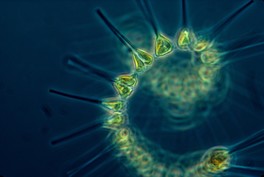 Looking Down to Improve the View from Above
For the next three years, researchers will look into the ocean to help improve the quality of data collected by satellites more than 500 miles above its surface. Their goal: determining how microscopic ocean algae, also known as phytoplankton, absorb and scatter light, and how their pigments or colors can be better identified and measured by satellite sensors. The team will collect plankton, water and continuous optical data, and observe phytoplankton during six NOAA Fisheries Ecosystem Monitoring Survey cruises over the next two years. The research team includes scientists from the Northeast Fisheries Science Center (NEFSC) and colleagues at the University of Rhode Island, NOAA’s National Environmental Satellite, Data and Information Service, and Woods Hole Oceanographic Institution. The first cruise was aboard the NOAA Ship Gordon Gunter in August. The second cruise is taking place November 1-14 on the R/V Hugh R. Sharp. Click here to learn more
|
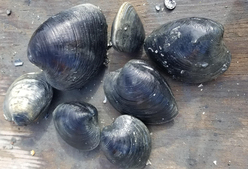 Milford Lab Dives Deep Into Shellfish in Greenwich Waters
The NEFSC Milford Lab conducted a shellfish survey October 1-5 in Greenwich, Connecticut from the R/V Victor Loosanoff. This survey is an important piece of an ongoing study to quantify the value of shellfish beyond the seafood market by measuring and modeling nutrient capture and local water quality improvements provided by clams and oysters. The study will also help coastal communities quantify the economic value of environmental benefits provided by shellfish. Click here to learn more
|
 Working with Fishermen to Understand Impacts of Climate on Flatfish
Waters off the Northeastern United States are rapidly changing and this change is impacting our fisheries. Working with the Massachusetts Division of Marine Fisheries and with New England groundfish fisherman, we are investigating how flatfish are changing their movements and habitat use in Southern New England and the Gulf of Maine in response to ocean warming. We are documenting fishermen’s observations of change and their thoughts about possible underlying causes for changes in flatfish ecology. We are also collecting information on how fishery regulations, economic factors, and other social forces are influencing fishing, and what fishermen can observe based on where and when they fish, and which species they target or avoid. The goal is to use the study results to inform how we use flatfish data gathered from our fisheries research surveys. This study is one of several climate-related research areas the NEFSC is currently leading. Click here to learn more
|
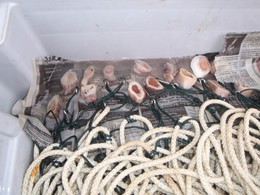 Fishing Industry, NEFSC Scientists Gear Up for Gulf of Maine Longline Study
The Cooperative Gulf of Maine Bottom Longline Survey is underway for the fifth consecutive year. Two Massachusetts commercial longline fishing vessels, F/V Mary Elizabeth and F/V Tenacious II, and the NEFSC Cooperative Research Branch are working in the Gulf of Maine for several weeks in October and November to survey fish species that live in rocky habitats.The cooperative survey uses tub-trawl bottom longline gear, which consists of hooks baited with squid attached to a one-nautical-mile mainline. The cruises have been timed to occur at about the same time as the long-running NEFSC bottom-trawl survey, and its 45-sampling stations are distributed over the same six sampling areas used for the federal survey. This makes it easier for analysts to compare the longline survey data to that collected in the bottom-trawl survey. Click here to learn more
|
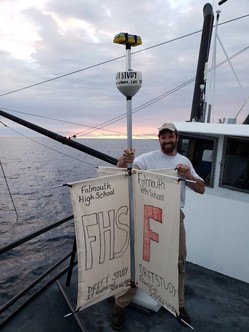 High School Students, Fishermen and Scientists Help Protect Sea Turtles
A surface drifter, developed by oceanographer James Manning of the NEFSC lab in Woods Hole to monitor ocean currents, was recently built and deployed by students at Falmouth High School in Massachusetts with help from Pt. Judith, Rhode Island fishing boat captain Chris Roebuck. Roebuck and Eric Matzen, of the NEFSC Gear Research Group, deployed the drifter near Hudson Canyon on October 14, 2018 during a cooperative project with the Southeast Fisheries Science Center testing the effectiveness of an installed turtle excluder device on the retention of the target catch. The drifter is outfitted with a waterproof transmitter that sends location data via satellite every four hours. It has enough battery power to communicate for a few months, and students will be able to record where the currents move the drifter over time. You can follow the drifter track and click here to learn more about this study.
|
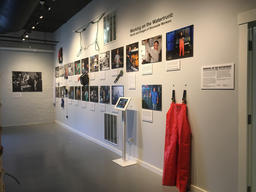 Kiosk in New Bedford Features Fishing Communities
The New Bedford Fishing Heritage Center and NOAA Fisheries have partnered on a new exhibit, “Working on the Waterfront,” featuring images and oral histories from 58 shore-based workers involved in a variety commercial fishing industry jobs. The exhibit includes an interactive oral history kiosk, supported by NOAA’s Voices from the Fisheries project, where fishermen speak about their job, their pride and passion for what they do, and what it means to be part of the fishing community. The audio recordings and related materials will become part of the Heritage Center’s archives and NOAA’s Voices from the Fisheries database, and will also be preserved in the American Folklife Center at the Library of Congress. This exhibit will remain on view through February 3, 2019. Upcoming exhibits will focus on the evolution of vessels, gear, and technology. Click here to learn more
|
 Milford Lab Holds Annual Open House
The NEFSC Milford Laboratory held its annual open house on October 12 and 13. The first day of the open house was for local and regional school groups, while the second day catered to the general public. Visitors learned about phytoplankton, shellfish health and breeding, interactions between shellfish aquaculture and the environment, field work in fisheries science, and the impact of changing ocean chemistry, or ocean acidification, on shellfish. Click here to learn more
|
|
|
|
|
|
|